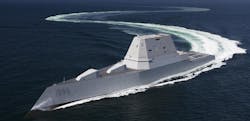Wanted: electrode materials for high-performance magnetohydrodynamic pumps in all-electric ship propulsion
ARLINGTON, Va. – U.S. military researchers are asking industry to develop electrode materials for high-performance magnetohydrodynamic pumps for future all-electric ship propulsion.
Officials of the U.S. Defense Advanced Research Projects Agency (DARPA) in Arlington, Va., issued a broad agency announcement (HR001123S0044) last week for the Principles of Undersea Magnetohydrodynamic Pumps (PUMP) project.
PUMP will develop and demonstrate magnetohydrodynamic pumps that match the efficiency, reduce the noise generation, and exceed the reliability of conventional impeller-based pumps for maritime propulsion. The program also will develop multi-physics modeling and simulation to design and analyze magnetohydrodynamic pumps.
Although military electric ship propulsion experts have been interested in magnetohydrodynamic technology for more than 60 years, materials for high-field magnets and corrosion-resistant electrodes have limited efficiency, size, weight, and power (SWaP), and longevity for practical applications, DARPA researchers say.
Related: Shipboard electronics steams into the 21st century
Experts have identified two main challenges to make magnetohydrodynamic practical: the need to increase the magnetic field for enhanced efficiency; and developing an electrode material to overcome the effects of hydrolysis, bubble collapse erosion, and corrosion in seawater.
The PUMP program is a 42-month effort in three phases: modeling and simulation tools; demonstrate an electrode material for a magnetohydrodynamic seawater environment; and demonstrate a small-scale prototype.
Modeling and simulation tools will include hydrodynamics, electrochemistry, and magnetics to help understand the magnetohydrodynamic environment; magnetohydrodynamic materials should be able to operate in seawater for at least five years; and the small-scale prototype should demonstrate an efficient system in a small-scale prototype magnetohydrodynamic unit capable of generating 22.5 pounds of force, expandable to about 56 pounds of force.
Related: Navy destroyers to increase efficiency and save fuel with new hybrid electric propulsion
There are two fundamental approaches to magnetohydrodynamic design: conductive and inductive. Conductive uses conductive electric and magnetic fields, while inductive operates with time-varying magnetic flux synchronized with time-varying current to maintain a given thrust. DARPA researchers say they expect to involve several contractors, with awards for inductive and conductive approaches.
Proposed solutions must address hydrolysis, corrosion, and bubble erosion. Hydrolysis can cause hydrogen to build on the cathode, and oxygen and chlorine to collect on the anode. A way to mitigate bubble buildup on the electrodes likely will be necessary.
Companies interested should submit abstracts no later than 13 June 2023, and full proposals no later than 31 July 2023 to the DARPA BAA website at https://baa.darpa.mil. Email questions and concerns to DARPA's Susan Swithenbank, the PUMP program manager, at [email protected]. More information is online at https://sam.gov/opp/94d360e2702240718bcaee0c260bb49f/view.
About the Author
John Keller
Editor-in-Chief
John Keller is the Editor-in-Chief, Military & Aerospace Electronics Magazine--provides extensive coverage and analysis of enabling electronics and optoelectronic technologies in military, space and commercial aviation applications. John has been a member of the Military & Aerospace Electronics staff since 1989 and chief editor since 1995.
